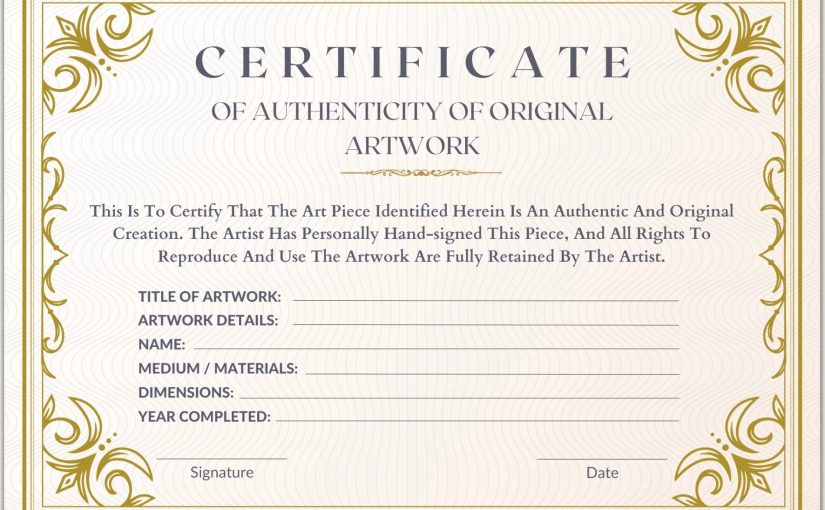So you’ve created a masterpiece. Maybe it’s a painting, a digital artwork, or a sculpture that looks like it could whisper secrets to da Vinci himself. But wait—before you send it out into the world (or Etsy), there’s one tiny yet mighty piece of paper that can make all the difference: the Artwork Certificate of Authenticity Template.
Yes, we’re talking about that sleek, official-looking document that says, “Hey, this art is legit!” It’s not just a fancy add-on—it’s a trust-builder, a value booster, and quite frankly, your artwork’s wingman.
Why You Need an Artwork Certificate of Authenticity Template
Let’s be honest, anyone with a decent printer and a Pinterest board could attempt to recreate your art (no offense, Becky). That’s where a certificate of authenticity (COA) steps in like a security guard with style. It helps:
- Prove the origin of your artwork
- Protect against forgery
- Increase buyer trust
- Add perceived value
- Serve as a record for future resales
A well-crafted artwork certificate of authenticity template is like the DNA of your artwork—customized, professional, and impossible to fake (unless your cousin Greg is REALLY good with Photoshop).
Key Elements of a Modern Certificate of Authenticity Art Template
Before you dive into Canva or start typing in Comic Sans (please don’t), let’s break down what a modern certificate of authenticity art template should include:
- Artist’s Name and Contact Info | Because “unknown artist” sounds more like a lost mixtape than a professional creator.
- Title of the Artwork | Keep it consistent with your catalog or website. No switching from “Whispers of the Sea” to “That Blue Thing I Made.”
- Date of Creation | This gives your artwork historical context and helps prevent future confusion about reprints or editions.
- Medium and Materials Used | Acrylic on canvas? Mixed media with gold leaf and glitter? Be specific.
- Dimensions | Size matters. Always.
- Edition Details | If it’s a limited edition certificate of authenticity template, list the edition number (like 3/50). This is crucial for collectors.
- Signature (yours!) | Because a COA without a signature is like a burrito without a tortilla—messy and hard to trust.
Design Tips for a Fine Art Certificate of Authenticity Template
Creating a fine art certificate of authenticity template is an art in itself. You want it to look professional but not like it came from a 2002 PowerPoint.
Choose a Sleek Layout
Go for clean lines, elegant fonts (no Papyrus!), and enough white space to let the text breathe. Remember, this is the tuxedo of your art’s documentation.
Use High-Quality Paper
If printing, use cardstock or archival paper. Thin printer paper? That’s for shopping lists.
Add a Logo or Watermark
Branding your COA gives it an official vibe. If you don’t have a logo, even a stylish signature or monogram can elevate the look.
Include a Small Image of the Artwork
Optional but recommended—this helps identify the piece visually and avoids confusion if titles are similar.
Types of Artwork Certificate Templates for Every Artist
Depending on your art and audience, you might want different styles of COAs. Let’s break down the major categories.
Limited Edition Certificate of Authenticity Template
This one’s for you if you produce numbered editions—photographs, prints, or sculptures. It should clearly state:
- Total edition size
- Individual piece number
- Notes on how it differs (if at all) from others in the edition
Collectors love this kind of clarity. And it screams exclusivity.
Get the Limited Edition Certificate of Authenticity Template Free now!
Modern Certificate of Authenticity Art Template
Minimalist. Clean. Digital-native. Perfect for artists who sell NFTs, digital art, or just have modern tastes.
These Certificate of Authenticity Templates often come in editable formats (like Word, PSD, or Google Docs) and are optimized for both print and digital delivery. Bonus points if it’s mobile-friendly for your art-on-the-go fans.
Fine Art Certificate of Authenticity Template
Classic and sophisticated. Think embossed seals, elegant borders, and museum-worthy presentation.
This style is ideal for traditional media like oil paintings, sculptures, or installations. It’s about giving your artwork the gravitas it deserves.
Where to Find or Create the Perfect Artwork Certificate of Authenticity Template
Whether you’re tech-savvy or prefer the drag-and-drop life, there are tools and websites that’ll help you build a COA without losing your mind.
- Canva – Great for custom, design-rich templates. Use their free layouts and tweak away.
- Creative Market – A treasure trove of elegant, ready-to-use templates.
- Etsy – Yes, you can buy COA templates from other artists. Circle of creative life.
- Paddleatthepoint – Not sexy, but reliable. You can find free downloadable Artwork Certificate of Authenticity Templates and customize to your heart’s content.
- Adobe InDesign / Illustrator – For the pros. Create templates that’ll make your art look like it came from Sotheby’s.
Final Thoughts: Your Art Deserves the Hype (and the Paperwork)
You’ve poured your soul into your work. Don’t let it walk out the door undocumented. A professional, polished artwork certificate of authenticity template doesn’t just protect your art—it elevates it.
Whether you’re printing one for a gallery show, emailing it to a collector in Tokyo, or adding it to your online shop, make sure it’s clear, beautiful, and unmistakably you.
Oh, and one last tip: Keep a copy for yourself. Because even the best artists forget where their masterpieces go sometimes (looking at you, Picasso).
TL;DR: A top-notch artwork certificate of authenticity template:
- Builds trust
- Prevents fakes
- Adds value
- Makes you look like the professional you are
Now go, artist—design that Artwork Certificate of Authenticity Template, sell that piece, and let your art conquer the world (with paperwork to prove it)!
